Lin Cheng
Adviser-Actor-Critic: Eliminating Steady-State Error in Reinforcement Learning Control
Feb 04, 2025Abstract:High-precision control tasks present substantial challenges for reinforcement learning (RL) algorithms, frequently resulting in suboptimal performance attributed to network approximation inaccuracies and inadequate sample quality.These issues are exacerbated when the task requires the agent to achieve a precise goal state, as is common in robotics and other real-world applications.We introduce Adviser-Actor-Critic (AAC), designed to address the precision control dilemma by combining the precision of feedback control theory with the adaptive learning capability of RL and featuring an Adviser that mentors the actor to refine control actions, thereby enhancing the precision of goal attainment.Finally, through benchmark tests, AAC outperformed standard RL algorithms in precision-critical, goal-conditioned tasks, demonstrating AAC's high precision, reliability, and robustness.Code are available at: https://anonymous.4open.science/r/Adviser-Actor-Critic-8AC5.
Error Distribution Smoothing:Advancing Low-Dimensional Imbalanced Regression
Feb 04, 2025Abstract:In real-world regression tasks, datasets frequently exhibit imbalanced distributions, characterized by a scarcity of data in high-complexity regions and an abundance in low-complexity areas. This imbalance presents significant challenges for existing classification methods with clear class boundaries, while highlighting a scarcity of approaches specifically designed for imbalanced regression problems. To better address these issues, we introduce a novel concept of Imbalanced Regression, which takes into account both the complexity of the problem and the density of data points, extending beyond traditional definitions that focus only on data density. Furthermore, we propose Error Distribution Smoothing (EDS) as a solution to tackle imbalanced regression, effectively selecting a representative subset from the dataset to reduce redundancy while maintaining balance and representativeness. Through several experiments, EDS has shown its effectiveness, and the related code and dataset can be accessed at https://anonymous.4open.science/r/Error-Distribution-Smoothing-762F.
Recursive Gaussian Process State Space Model
Nov 22, 2024Abstract:Learning dynamical models from data is not only fundamental but also holds great promise for advancing principle discovery, time-series prediction, and controller design. Among various approaches, Gaussian Process State-Space Models (GPSSMs) have recently gained significant attention due to their combination of flexibility and interpretability. However, for online learning, the field lacks an efficient method suitable for scenarios where prior information regarding data distribution and model function is limited. To address this issue, this paper proposes a recursive GPSSM method with adaptive capabilities for both operating domains and Gaussian process (GP) hyperparameters. Specifically, we first utilize first-order linearization to derive a Bayesian update equation for the joint distribution between the system state and the GP model, enabling closed-form and domain-independent learning. Second, an online selection algorithm for inducing points is developed based on informative criteria to achieve lightweight learning. Third, to support online hyperparameter optimization, we recover historical measurement information from the current filtering distribution. Comprehensive evaluations on both synthetic and real-world datasets demonstrate the superior accuracy, computational efficiency, and adaptability of our method compared to state-of-the-art online GPSSM techniques.
Graph Attention-Based Symmetry Constraint Extraction for Analog Circuits
Dec 22, 2023



Abstract:In recent years, analog circuits have received extensive attention and are widely used in many emerging applications. The high demand for analog circuits necessitates shorter circuit design cycles. To achieve the desired performance and specifications, various geometrical symmetry constraints must be carefully considered during the analog layout process. However, the manual labeling of these constraints by experienced analog engineers is a laborious and time-consuming process. To handle the costly runtime issue, we propose a graph-based learning framework to automatically extract symmetric constraints in analog circuit layout. The proposed framework leverages the connection characteristics of circuits and the devices'information to learn the general rules of symmetric constraints, which effectively facilitates the extraction of device-level constraints on circuit netlists. The experimental results demonstrate that compared to state-of-the-art symmetric constraint detection approaches, our framework achieves higher accuracy and lower false positive rate.
Simple but Effective Unsupervised Classification for Specified Domain Images: A Case Study on Fungi Images
Nov 15, 2023



Abstract:High-quality labeled datasets are essential for deep learning. Traditional manual annotation methods are not only costly and inefficient but also pose challenges in specialized domains where expert knowledge is needed. Self-supervised methods, despite leveraging unlabeled data for feature extraction, still require hundreds or thousands of labeled instances to guide the model for effective specialized image classification. Current unsupervised learning methods offer automatic classification without prior annotation but often compromise on accuracy. As a result, efficiently procuring high-quality labeled datasets remains a pressing challenge for specialized domain images devoid of annotated data. Addressing this, an unsupervised classification method with three key ideas is introduced: 1) dual-step feature dimensionality reduction using a pre-trained model and manifold learning, 2) a voting mechanism from multiple clustering algorithms, and 3) post-hoc instead of prior manual annotation. This approach outperforms supervised methods in classification accuracy, as demonstrated with fungal image data, achieving 94.1% and 96.7% on public and private datasets respectively. The proposed unsupervised classification method reduces dependency on pre-annotated datasets, enabling a closed-loop for data classification. The simplicity and ease of use of this method will also bring convenience to researchers in various fields in building datasets, promoting AI applications for images in specialized domains.
All-pairs Consistency Learning for Weakly Supervised Semantic Segmentation
Aug 08, 2023



Abstract:In this work, we propose a new transformer-based regularization to better localize objects for Weakly supervised semantic segmentation (WSSS). In image-level WSSS, Class Activation Map (CAM) is adopted to generate object localization as pseudo segmentation labels. To address the partial activation issue of the CAMs, consistency regularization is employed to maintain activation intensity invariance across various image augmentations. However, such methods ignore pair-wise relations among regions within each CAM, which capture context and should also be invariant across image views. To this end, we propose a new all-pairs consistency regularization (ACR). Given a pair of augmented views, our approach regularizes the activation intensities between a pair of augmented views, while also ensuring that the affinity across regions within each view remains consistent. We adopt vision transformers as the self-attention mechanism naturally embeds pair-wise affinity. This enables us to simply regularize the distance between the attention matrices of augmented image pairs. Additionally, we introduce a novel class-wise localization method that leverages the gradients of the class token. Our method can be seamlessly integrated into existing WSSS methods using transformers without modifying the architectures. We evaluate our method on PASCAL VOC and MS COCO datasets. Our method produces noticeably better class localization maps (67.3% mIoU on PASCAL VOC train), resulting in superior WSSS performances.
Intelligent diagnostic scheme for lung cancer screening with Raman spectra data by tensor network machine learning
Mar 11, 2023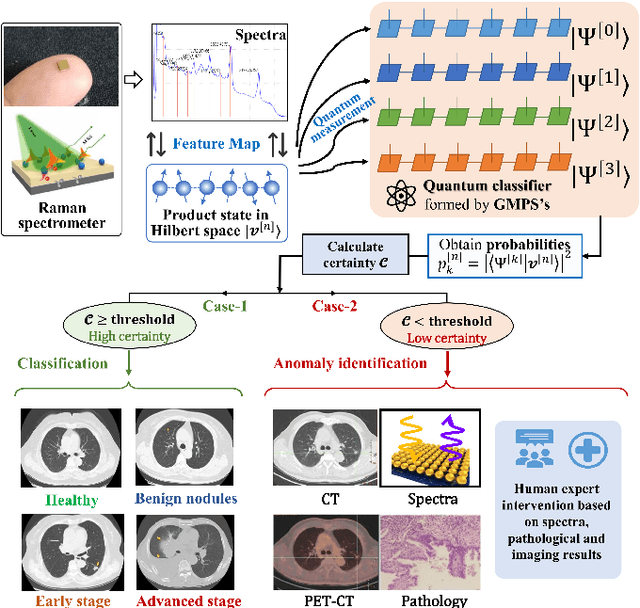
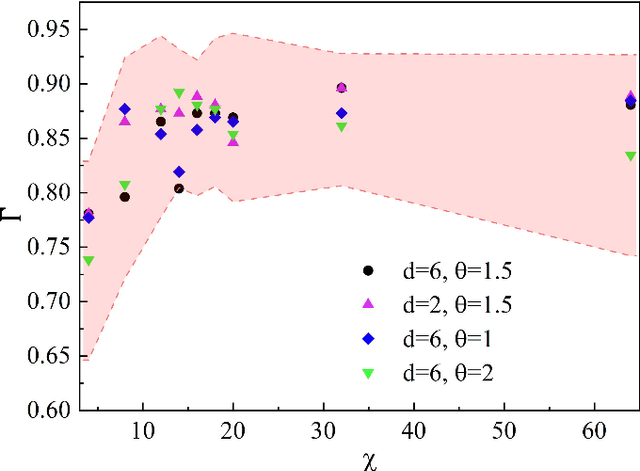
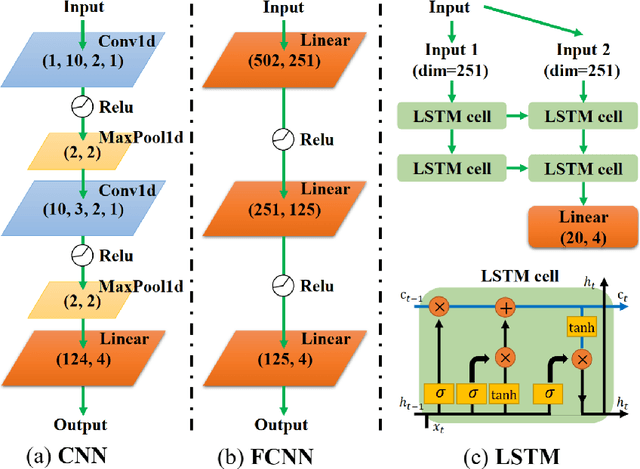
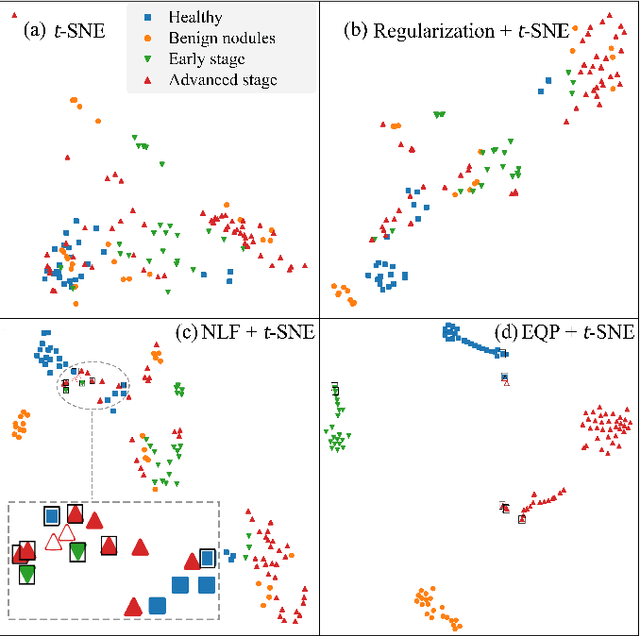
Abstract:Artificial intelligence (AI) has brought tremendous impacts on biomedical sciences from academic researches to clinical applications, such as in biomarkers' detection and diagnosis, optimization of treatment, and identification of new therapeutic targets in drug discovery. However, the contemporary AI technologies, particularly deep machine learning (ML), severely suffer from non-interpretability, which might uncontrollably lead to incorrect predictions. Interpretability is particularly crucial to ML for clinical diagnosis as the consumers must gain necessary sense of security and trust from firm grounds or convincing interpretations. In this work, we propose a tensor-network (TN)-ML method to reliably predict lung cancer patients and their stages via screening Raman spectra data of Volatile organic compounds (VOCs) in exhaled breath, which are generally suitable as biomarkers and are considered to be an ideal way for non-invasive lung cancer screening. The prediction of TN-ML is based on the mutual distances of the breath samples mapped to the quantum Hilbert space. Thanks to the quantum probabilistic interpretation, the certainty of the predictions can be quantitatively characterized. The accuracy of the samples with high certainty is almost 100$\%$. The incorrectly-classified samples exhibit obviously lower certainty, and thus can be decipherably identified as anomalies, which will be handled by human experts to guarantee high reliability. Our work sheds light on shifting the ``AI for biomedical sciences'' from the conventional non-interpretable ML schemes to the interpretable human-ML interactive approaches, for the purpose of high accuracy and reliability.
Reinforcement Learning for Standards Design
Oct 13, 2021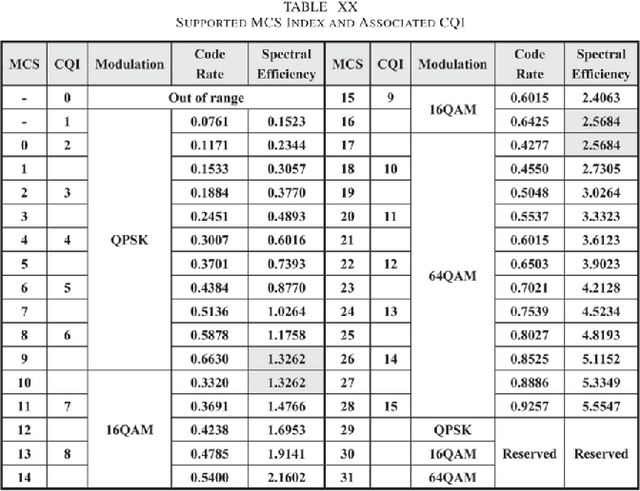

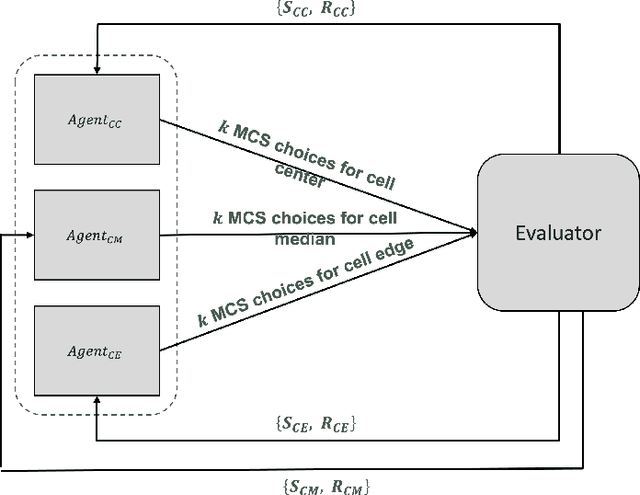
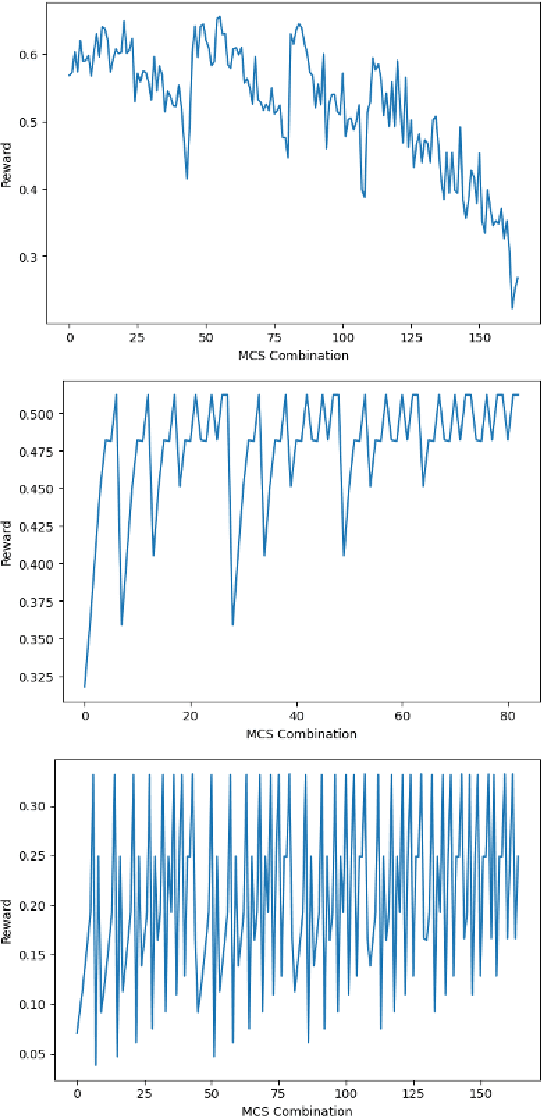
Abstract:Communications standards are designed via committees of humans holding repeated meetings over months or even years until consensus is achieved. This includes decisions regarding the modulation and coding schemes to be supported over an air interface. We propose a way to "automate" the selection of the set of modulation and coding schemes to be supported over a given air interface and thereby streamline both the standards design process and the ease of extending the standard to support new modulation schemes applicable to new higher-level applications and services. Our scheme involves machine learning, whereby a constructor entity submits proposals to an evaluator entity, which returns a score for the proposal. The constructor employs reinforcement learning to iterate on its submitted proposals until a score is achieved that was previously agreed upon by both constructor and evaluator to be indicative of satisfying the required design criteria (including performance metrics for transmissions over the interface).
TSG: Target-Selective Gradient Backprop for Probing CNN Visual Saliency
Oct 11, 2021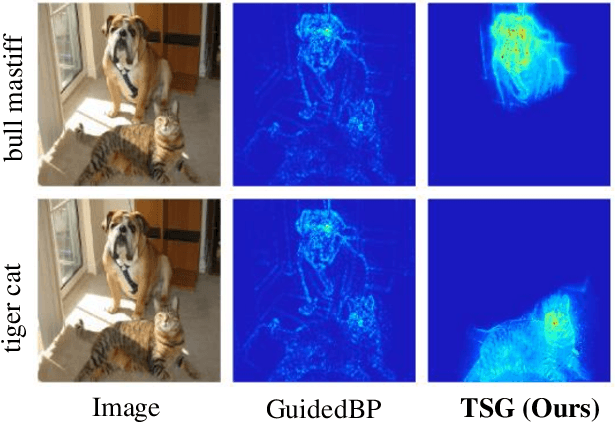
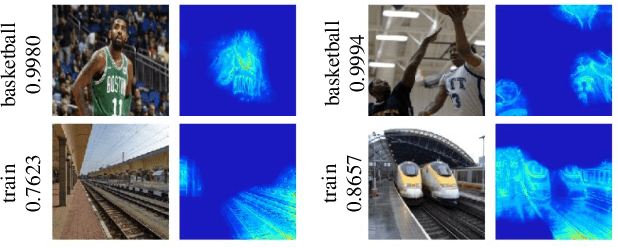
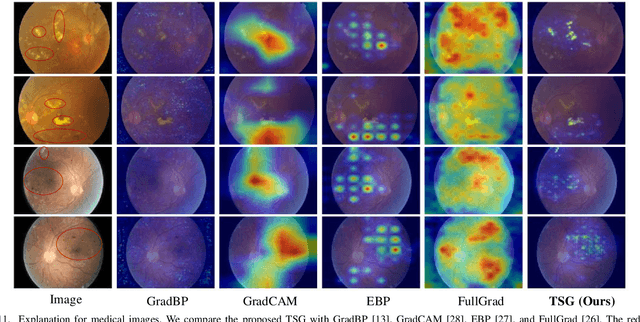
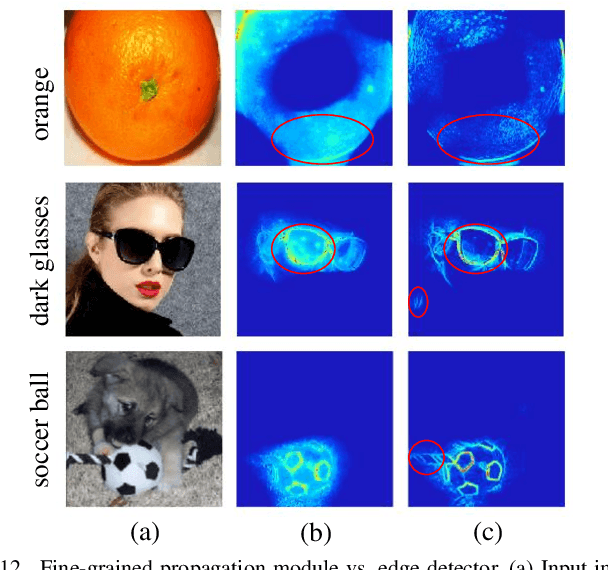
Abstract:The explanation for deep neural networks has drawn extensive attention in the deep learning community over the past few years. In this work, we study the visual saliency, a.k.a. visual explanation, to interpret convolutional neural networks. Compared to iteration based saliency methods, single backward pass based saliency methods benefit from faster speed and are widely used in downstream visual tasks. Thus our work focuses on single backward pass approaches. However, existing methods in this category struggle to successfully produce fine-grained saliency maps concentrating on specific target classes. That said, producing faithful saliency maps satisfying both target-selectiveness and fine-grainedness using a single backward pass is a challenging problem in the field. To mitigate this problem, we revisit the gradient flow inside the network, and find that the entangled semantics and original weights may disturb the propagation of target-relevant saliency. Inspired by those observations, we propose a novel visual saliency framework, termed Target-Selective Gradient (TSG) backprop, which leverages rectification operations to effectively emphasize target classes and further efficiently propagate the saliency to the input space, thereby generating target-selective and fine-grained saliency maps. The proposed TSG consists of two components, namely, TSG-Conv and TSG-FC, which rectify the gradients for convolutional layers and fully-connected layers, respectively. Thorough qualitative and quantitative experiments on ImageNet and Pascal VOC show that the proposed framework achieves more accurate and reliable results than other competitive methods.
GRCNN: Graph Recognition Convolutional Neural Network for Synthesizing Programs from Flow Charts
Nov 11, 2020



Abstract:Program synthesis is the task to automatically generate programs based on user specification. In this paper, we present a framework that synthesizes programs from flow charts that serve as accurate and intuitive specifications. In order doing so, we propose a deep neural network called GRCNN that recognizes graph structure from its image. GRCNN is trained end-to-end, which can predict edge and node information of the flow chart simultaneously. Experiments show that the accuracy rate to synthesize a program is 66.4%, and the accuracy rates to recognize edge and nodes are 94.1% and 67.9%, respectively. On average, it takes about 60 milliseconds to synthesize a program.
 Add to Chrome
Add to Chrome Add to Firefox
Add to Firefox Add to Edge
Add to Edge